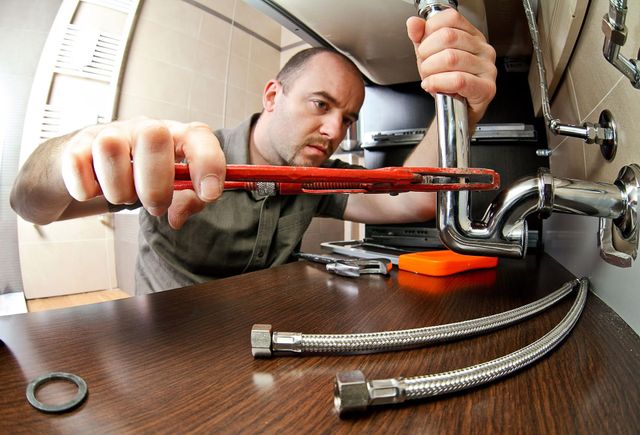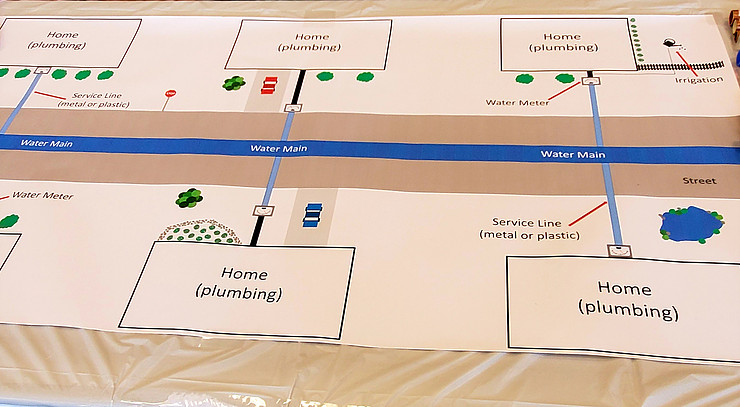Important Parts of Your House's Plumbing System
Important Parts of Your House's Plumbing System
Blog Article
Are you currently trying to find info on Anatomy of a House: Understanding the Components?

Understanding exactly how your home's pipes system works is essential for each house owner. From delivering tidy water for drinking, cooking, and showering to safely getting rid of wastewater, a well-maintained pipes system is essential for your family members's health and wellness and convenience. In this thorough guide, we'll discover the elaborate network that composes your home's plumbing and deal pointers on maintenance, upgrades, and taking care of usual problems.
Intro
Your home's plumbing system is greater than simply a network of pipes; it's an intricate system that ensures you have access to tidy water and effective wastewater elimination. Knowing its elements and exactly how they interact can assist you avoid pricey repair work and ensure whatever runs efficiently.
Basic Parts of a Pipes System
Pipes and Tubes
At the heart of your plumbing system are the pipes and tubing that bring water throughout your home. These can be made of various products such as copper, PVC, or PEX, each with its advantages in regards to resilience and cost-effectiveness.
Components: Sinks, Toilets, Showers, etc.
Fixtures like sinks, commodes, showers, and bath tubs are where water is utilized in your house. Comprehending just how these fixtures connect to the pipes system aids in diagnosing issues and preparing upgrades.
Shutoffs and Shut-off Factors
Shutoffs control the flow of water in your plumbing system. Shut-off shutoffs are crucial throughout emergencies or when you require to make fixings, permitting you to separate parts of the system without interfering with water flow to the entire house.
Water System System
Main Water Line
The primary water line links your home to the local supply of water or a personal well. It's where water enters your home and is dispersed to various fixtures.
Water Meter and Pressure Regulator
The water meter measures your water usage, while a pressure regulator guarantees that water flows at a safe pressure throughout your home's plumbing system, avoiding damage to pipes and components.
Cold Water vs. Warm water Lines
Recognizing the distinction between cold water lines, which supply water directly from the main, and hot water lines, which carry warmed water from the hot water heater, aids in repairing and preparing for upgrades.
Water drainage System
Drain Pipes Water Lines and Traps
Drain pipelines bring wastewater far from sinks, showers, and bathrooms to the drain or sewage-disposal tank. Traps avoid sewer gases from entering your home and also trap particles that can create blockages.
Ventilation Pipes
Air flow pipelines permit air right into the drainage system, protecting against suction that might slow drainage and create catches to empty. Proper ventilation is essential for keeping the honesty of your plumbing system.
Significance of Proper Water Drainage
Guaranteeing proper water drainage stops backups and water damage. Routinely cleaning up drains and maintaining catches can stop pricey repair work and expand the life of your pipes system.
Water Heating Unit
Kinds Of Water Heaters
Water heaters can be tankless or typical tank-style. Tankless heaters warmth water on demand, while tanks save heated water for immediate usage.
How Water Heaters Attach to the Plumbing System
Recognizing just how water heaters link to both the cold water supply and warm water circulation lines aids in identifying concerns like insufficient warm water or leakages.
Upkeep Tips for Water Heaters
On a regular basis flushing your water heater to get rid of debris, checking the temperature level setups, and examining for leaks can prolong its life expectancy and enhance energy performance.
Common Plumbing Concerns
Leaks and Their Causes
Leakages can take place due to aging pipelines, loosened fittings, or high water pressure. Resolving leaks promptly prevents water damages and mold and mildew development.
Clogs and Blockages
Blockages in drains pipes and bathrooms are typically caused by flushing non-flushable things or a buildup of oil and hair. Utilizing drain displays and bearing in mind what goes down your drains can stop clogs.
Signs of Plumbing Problems to Expect
Low water stress, sluggish drains, foul odors, or uncommonly high water bills are indicators of potential pipes problems that must be dealt with without delay.
Plumbing Maintenance Tips
Regular Assessments and Checks
Schedule yearly pipes evaluations to capture issues early. Seek indicators of leaks, deterioration, or mineral buildup in faucets and showerheads.
Do It Yourself Maintenance Tasks
Basic tasks like cleansing faucet aerators, looking for commode leaks making use of dye tablets, or shielding exposed pipelines in cool climates can stop significant plumbing problems.
When to Call a Professional Plumbing Technician
Know when a plumbing problem calls for specialist competence. Trying complicated fixings without proper understanding can lead to more damages and higher repair service prices.
Upgrading Your Pipes System
Reasons for Upgrading
Upgrading to water-efficient components or changing old pipes can boost water top quality, decrease water expenses, and increase the value of your home.
Modern Pipes Technologies and Their Advantages
Explore modern technologies like smart leak detectors, water-saving commodes, and energy-efficient water heaters that can save cash and decrease ecological impact.
Cost Factors To Consider and ROI
Calculate the ahead of time expenses versus lasting financial savings when considering plumbing upgrades. Lots of upgrades spend for themselves with minimized energy costs and less repairs.
Environmental Effect and Conservation
Water-Saving Components and Devices
Mounting low-flow taps, showerheads, and toilets can considerably decrease water use without sacrificing performance.
Tips for Minimizing Water Usage
Basic practices like repairing leaks promptly, taking much shorter showers, and running complete tons of washing and dishes can preserve water and reduced your utility expenses.
Eco-Friendly Plumbing Options
Consider lasting pipes products like bamboo for flooring, which is durable and environmentally friendly, or recycled glass for counter tops.
Emergency Preparedness
Steps to Take During a Pipes Emergency situation
Know where your shut-off shutoffs are located and just how to switch off the water system in case of a ruptured pipe or significant leakage.
Value of Having Emergency Calls Useful
Maintain call information for local plumbers or emergency services conveniently available for quick response throughout a pipes dilemma.
DIY Emergency Situation Fixes (When Appropriate).
Short-lived solutions like making use of duct tape to patch a dripping pipeline or placing a pail under a leaking tap can reduce damages until a specialist plumbing shows up.
Final thought.
Recognizing the composition of your home's plumbing system equips you to preserve it effectively, conserving money and time on repair work. By adhering to regular maintenance routines and staying educated about modern-day pipes modern technologies, you can guarantee your plumbing system operates efficiently for many years to come.
HOW YOUR PLUMBING SYSTEM WORKS
Which Pipes Do What?
Blue lines = fresh water supply entering the building
Red lines = hot water supply entering the building
Grey lines = pipes carrying waste away from the building and venting pipes carrying gases away from the building (through the roof)
YOUR MAIN PLUMBING SYSTEMS
There are two main plumbing systems that support your home s basic plumbing needs one that brings clean water into your home, and one that sends dirty water away from your home. Connected to the toilet, bath, shower, and other faucets in your home, these two systems keep your water flowing in the right directions.
ACCESSING FRESH WATER
Fresh and clean water is brought into your home through the main water supply line . Filtered through one pipe, this water is pressured to flow into the various fixtures in your home at any given time.
This water can be sourced from a well located on your property, a pond or river (mostly cottages), or, as in most cases, from the city s municipal water treatment centre. However, it is important to note that water that is untreated, such as the water siphoned from ponds or rivers, may not be safe to drink. Personal water supplies always need to be treated for hardness and contaminants before consumed.
MUNICIPAL WATER SUPPLIES
Improve taste and odour
Remove sediment
Eliminate hardness
Reduce chlorine
COLD WATER SUPPLY VS. HOT WATER SUPPLY
Cold water flows into your home or building through the service line, which then distributes hot or cold water to your fixtures. This line is most commonly run through a central column that runs floor to floor. Hot water runs in short and straight pipes as the longer the pipeline, the more heat that will be lost in the transfer. Having shorter pipes also allows residents to access hot water more quickly.
WASTE WATER SYSTEM
Your wastewater system is divided into two parts pipes that send wastewater away from your home and venting pipes that send sewer gas away from your home. Sewage water travels through pipes that flush the water and waste towards local sewers that are operated and managed by your city or town. Most sewer systems rely on gravity to move the wastewater to where it needs to go.
The further away from your toilet or sink, the larger wastewater pipes become. This allows for waste to be disposed of from various parts of your home or business at once without pipe blockages. The angle and flow of these pipes are also essential for keeping your waste pipes clear of build up.
https://harrisplumbing.ca/how-your-home-plumbing-system-works/

HOW YOUR PLUMBING SYSTEM WORKS
Which Pipes Do What?
YOUR MAIN PLUMBING SYSTEMS
There are two main plumbing systems that support your home s basic plumbing needs one that brings clean water into your home, and one that sends dirty water away from your home. Connected to the toilet, bath, shower, and other faucets in your home, these two systems keep your water flowing in the right directions.
ACCESSING FRESH WATER
Fresh and clean water is brought into your home through the main water supply line . Filtered through one pipe, this water is pressured to flow into the various fixtures in your home at any given time.
This water can be sourced from a well located on your property, a pond or river (mostly cottages), or, as in most cases, from the city s municipal water treatment centre. However, it is important to note that water that is untreated, such as the water siphoned from ponds or rivers, may not be safe to drink. Personal water supplies always need to be treated for hardness and contaminants before consumed.
MUNICIPAL WATER SUPPLIES
COLD WATER SUPPLY VS. HOT WATER SUPPLY
Cold water flows into your home or building through the service line, which then distributes hot or cold water to your fixtures. This line is most commonly run through a central column that runs floor to floor. Hot water runs in short and straight pipes as the longer the pipeline, the more heat that will be lost in the transfer. Having shorter pipes also allows residents to access hot water more quickly.
WASTE WATER SYSTEM
Your wastewater system is divided into two parts pipes that send wastewater away from your home and venting pipes that send sewer gas away from your home. Sewage water travels through pipes that flush the water and waste towards local sewers that are operated and managed by your city or town. Most sewer systems rely on gravity to move the wastewater to where it needs to go.
The further away from your toilet or sink, the larger wastewater pipes become. This allows for waste to be disposed of from various parts of your home or business at once without pipe blockages. The angle and flow of these pipes are also essential for keeping your waste pipes clear of build up.
https://harrisplumbing.ca/how-your-home-plumbing-system-works/
I discovered that piece of writing about The Inner Workings of Your Home's Plumbing while browsing the internet. Are you aware of another individual who is fascinated about the subject? Feel free to promote it. Thank-you for taking the time to read it.
Detail Report this page